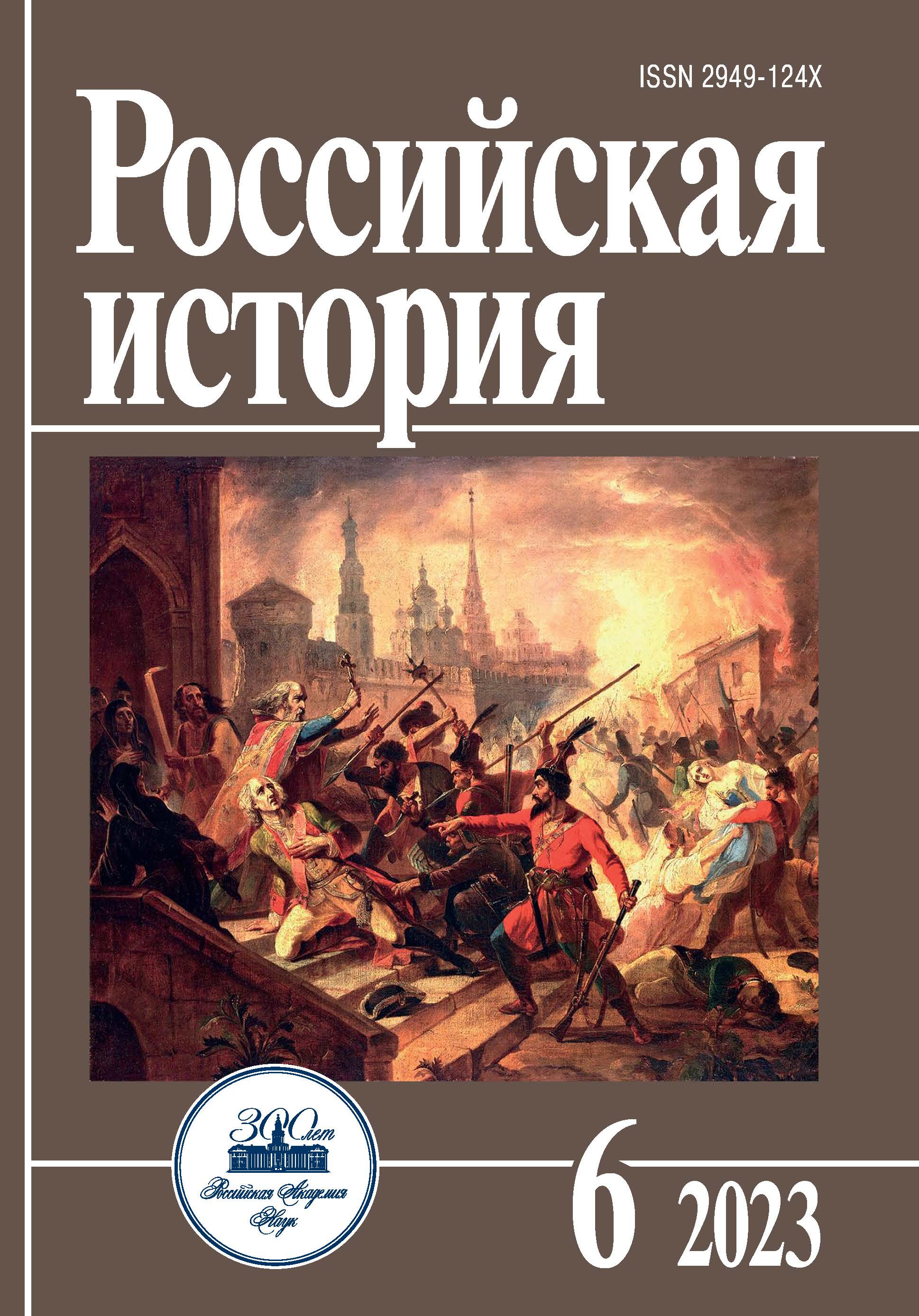The Pugachev uprising in the historiography of Central and Western Europe in the first quarter of the 21st century
- 作者: Natalizi M.1
-
隶属关系:
- University of Genoa
- 期: 编号 6 (2023)
- 页面: 3-12
- 栏目: Articles
- URL: https://rjmseer.com/2949-124X/article/view/663639
- DOI: https://doi.org/10.31857/S2949124X23060019
- EDN: https://elibrary.ru/NRAHBZ
- ID: 663639
如何引用文章
详细
For thirty years now, the history of the Pugachev uprising has been experiencing a rapid process of rethinking the analytical categories and interpretations that had been used in historiography seventy years before. This process of rethinking has gone so far as to completely overturn achievements traditionally considered firmly established, with a consequent fragmentation of the theoretical foundations on which they rested. New interpretations, developing at different times, in different ways and with different goals, stemmed from a common beginning - criticism of the Marxist interpretation of the uprising. Revisiting the Soviet interpretation of the Pugachev uprising as a class war between peasants and nobles, English-language and European writers outside Russia emphasized other aspects of the uprising, especially when it came to the movement to restore Cossack autonomy and the protest of peripheral ethnic groups and nationalities. This article aims to demonstrate how this thesis of the peripheral revolt has shown in recent years that it still leaves several places open for further thought, and what its recent updates have been in the historiography of Central and Western Europe.
参考
- Воззвания и переписка вожаков пугачевского движения в Поволжье и Приуралье / Сост. М.А. Усманов и др. Казань, 1988.
- Документы ставки Е.И. Пугачева, повстанческих властей и учреждений / Отв. ред. Р.В. Овчинников. М., 1975.
- Емельян Пугачев на следствии. Сборник документов и материалов. М., 1997.
- Крестьянская война под предводительством Е.И. Пугачева в Марийском крае / Сост. и авт. поясн. текста А.Г. Иванов. Йошкар-Ола, 1989.
- Мавродин В.В. Советская историческая литература о крестьянских войнах в России XVII-XVIII веков // Вопросы истории. 1961. № 5. С. 24-47.
- Мауль В.Я. Российская историография начала ХХI века о пугачевском бунте (некоторые аспекты проблемы) // Вестник Сургутского государственного педагогического университета. 2015. № 4(37).
- Овчинников Р.В. Манифесты и указы Е.И. Пугачева. М., 1980.
- Овчинников Р.В. Следствие и суд над Е.И. Пугачевым и его сподвижниками. М., 1995.
- Павленко Н.И. Екатерина Великая. М., 1999.
- Рожков Н.А. Методика преподавания истории и история XIX века. Пг., 1918.
- Рожков Н.А. Русская история в сравнительно-историческом освещении (основы социальной динамики). Т. 4. Ч. I. Пг., 1922.
- Шарф К. Пугачев: император между периферией и центром. К постановке проблемы // Ab Imperio. 2003. № 1. С. 99-113.
- Alexander J.T. Emperor of the Cossacks. Pugachev and the Frontier Jacquerie of 1773-1775. Lawrence, Kansas, 1973.
- Avrich P. Russian Rebels 1600-1800. New York, 1972.
- Berelowitch A. Une jacquerie moderne: la révolte de Pougatchëv (17 septembre 1773 - 15 septembre 1774) // Revue russe. 2005. № 27, P. 37.59.
- Berelovitch W. La grande insurrection de Pougatchev (1773-1775): la révolte des primitifs // Révoltes et révolutions en Europe (Russie comprise) et aux Amériques de 1783 à 1802. Paris, 2004. P. 61-81.
- Berelovitch W. Aux origines de l’insurrection de Pougathchev (1773-1775): la cosaquerie russe // Ruptures de la fin du XVIII-e siècle. Paris, 2005, P. 39-50.
- Berelowitch W. Guerres civiles et révoltes populaires dans la Russie des XVIIe et XVIIIe siècles // La Guerre civile. Hermann, 2018, P. 217-228.
- Cecere D. Violenza, resistenze, progettualità politica. La ribellione di Pugačëv // Studi Storici. Ottobre-dicembre 2012. Anno 53. № 4. P. 1017-1025.
- Griesse M. Popular memory and early modern revolts in Russia. From Razin to Pugachev // Rhytms of revolt: European Traditions and Memories of Social Conflict in Oral Culture. London; New York, 2017. P. 198-216.
- Griesse M. Pugačev-Bilder vor der Kanonisierung: Transnationale Deutungskämpfe in der Vormoderne // Jahrbücher für Geschichte Osteuropas. 2017. Bd. 65. № 1. P. 52-72.
- Griesse M., Barget M. Revolts and Political Violence in Early Modern Imagery. Brill, Leiden-Boston, 2022.
- Griesse M. Pugachev Goes Global: The Revolutionary Potential of Translation // Reverberations of Revolution. Transnational Perspectives, 1750-1850. Edinburgh, 2022. P. 13-35.
- Kappeler A. Russland als Vielvölkerreich. München, 1993.
- Kappeler A. Russlands erste Nationalitäten. Das Zarenreich und die Völker der Mittleren Wolga vom 16. Bis 19. Köln-Wien, 1982.
- Kappeler A. Russlands Frontier in der Frühen Neuzeit // Frieden und Krieg in der Frühen Neuzeit. Die europäische Staatenordnung und die aussereuropäische Welt. München, 2001. P. 599-613.
- Ingerflom C.S. Le Tsar, c’est moi: L’imposture permanente, d’Ivan le Terrible à Vladimir Poutine. Paris, 2015.
- Liechtenhan F.-D. Catherine II. Le courage triumphant. Paris, 2021.
- Natalizi M. Emel’jan Ivanovič Pugačëv: una rilettura // Storica. 2010. № 47. P. 61-102.
- Natalizi M. La rivolta degli orfani. La vicenda del ribelle Pugačëv. Roma, 2011.
- Neutatz D. Die Umdeutung von Razin und Pugačev in der Sowjetunion unter Lenin und Stalin // Kosakische Aufstände und ihre Anführer. Ed. Malte Griesse, Stuttgart, Steiner, 2017. P. 113-131.
- Plate A. Der Pugačev-Aufstand: Kosakenherrlichkeit oder sozialer Protest // Volksaustände in Russland. Von der Zeit der Wirren bis zur «Grünen Revolution» egen die Sowietherrschaft. Wiesbaden, 2006. P. 353-396.
- Perrie M. «Royal Marks»: Reading the Bodies of Russian Pretenders, 17th-19th Centuries // Kritika: Explorations in Russian and Eurasian History. Vol. 11. № 3. Summer 2010. P. 535-561.
- Raeff M. Pugachev’s Rebellion // Preconditions of Revolution in Early Modern Europe. Vol. 10. Baltimore and London, 1970. P. 161-202.
- Steinwedel C. Threads of Empire: Loyalty and Tsarist Authority in Bashkiria, 1552-1917. Bloomington, 2016.
- Tucker S. Pugachev’s rebellion (1773-1775) // The Roots and Consequences of Civil Wars and Revolutions. Conflict That Changed World History. Santa Barbara (California); Denver (Colorado), 2017. P. 139-146.
- Venturi F. Settecento riformatore, III. La prima crisi dell’antico Regime (1768-1776). Torino, 1979.
补充文件









